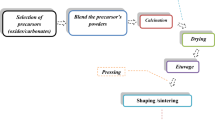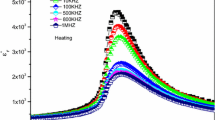Abstract
The influence of the barium concentration on the dielectric response of Sr1−x Ba x Bi2Nb2O9 system, with x = 0, 15, 30, 50, 70, 85, 100 at.%, has been studied. The barium concentration dependence of T m, as well as the temperature of the corresponding maximum for the real part of the dielectric permittivity, has suggested a cation site mixing among atomic positions, which has been supported by the structural analysis. A transition from normal ferroelectric–paraelectric phase transition to a relaxor behavior has been observed in the studied samples, when the barium concentration has increased. The relaxor behavior has been discussed.






Similar content being viewed by others
References
Snedden A, Hervoches ChH, Lightfoot P (2003) Ferroelectric phase transitions in SrBi2Nb2O9 and Bi5Ti3FeO15: a powder neutron diffraction study. Phys Rev B 67:092102
Shrivastava V, Jha AK, Mendiratta RG (2005) Structural distortion and phase transition studies of Aurivillius type Sr1−x Pb x Bi2Nb2O9 ferroelectric ceramics. Solid State Commun 133:125–129
Fang P, Fan H, Li J, Liang F (2010) Lanthanum induced larger polarization and dielectric relaxation in Aurivillius phase SrBi2−x La x Nb2O9 ferroelectric ceramics. J Appl Phys 107:064104
Cheng ZX, Wang XL, Zhao HY, Kimura H (2010) Lead-free potassium bismuth titanate thin film with complex Aurivillius layer structure. J Appl Phys 107:084105
Kumar S, Varma KBR (2008) Structural and dielectric properties of Bi4Ti2Nb0.5Fe0.5O12 ceramics. Solid State Commun 146:137–142
Mercurio D, Trolliarda G, Hansenb T, Mercurio JP (2000) Crystal structure of the ferroelectric mixed Aurivillius phase Bi7Ti4NbO21. Inter J Inorg Mater 2:397–406
Perez-Mato JM, Aroyo M, García A, Blaha P, Schwarz K, Schweifer J, Parlinski K (2004) Competing structural instabilities in the ferroelectric Aurivillius compound SrBi2Ta2O9. Phys Rev B 70:214111
Nuzhnyy D, Kamba S, Kužel P, Veljko S, Bovtun V, Savinov M, Petzelt J, Amorín H, Costa MEV, Kholkin AL, Boullay Ph, Adamczyk M (2006) Dynamics of the phase transitions in Bi-layered ferroelectrics with Aurivillius structure: dielectric response in the terahertz spectral range. Phys Rev B 74:134105–134107
Haluska MS, Misture ST (2004) Crystal structure refinements of the three-layer Aurivillius ceramics Bi2Sr2−x A x Nb2TiO12 (A = Ca, Ba; x = 0, 0.5, 1) using combined X-ray and neutron powder diffraction. J Solid State Chem 177:1965–1975
Kennedy BJ, Ismunandar (1999) Effect of temperature on cation disorder in ABi2Nb2O9 (A = Sr, Ba). J Mater Chem 9:541–544
Borg S, Svensson G, Bovin J (2002) Structure study of Bi2.5Na0.5Ta2O9 and Bi2.5Nam−1.5NbmO3m+3 (m = 2–4) by neutron powder diffraction and electron microscopy. J Solid State Chem 167:86–96
Wachsmuth B, Zschech E, Thomas NW, Brodie SG, Gurman SJ, Baker S, Bayliss SC (1993) Structure model of aurivillius compounds. Phys State Solid (a) 135:59–71
Wu Y, Forbess MJ, Seraji S, Limmer SJ, Chou TP, Nguyen C, Cao GZ (2001) Doping effect in layer structured SrBi2Nb2O9 ferroelectrics. J Appl Phys 90:5296–6002
Huang S, Feng Ch, Chen L, Wang Q (2006) Relaxor behavior of Sr1–x Ba x Bi2Nb2O9 ceramics. J Am Ceram Soc 89:328–331
Kholkin AL, Avdeev M, Costa MEV, Baptista JL, Dorogotsev SN (2001) Dielectric relaxation in Ba-based layered perovskites. Appl Phys Lett 79:662–664
Miranda C, Costa MEV, Avdeev M, Kholkin AL, Baptista JL (2001) Relaxor properties of Ba-based layered perovskites. J Eur Ceram Soc 21:1303–1306
Blake SM, Falconer MJ, McCreedy M, Lightfoot P (1997) Cation disorder in ferroelectric Aurivillius phases of the type Bi2ANb2O9 (A = Ba, Sr, Ca). J Mater Chem 7:1609–1613
González-Abreu Y, Peláiz-Barranco A, Araújo EB, Franco Júnior A (2009) Dielectric relaxation and relaxor behavior in bi-layered perovskites. Appl Phys Lett 94:262903
Peláiz-Barranco A, González-Abreu Y (2012) Dielectric relaxation mechanisms in relaxor Bi-layered perovskites. Ferroelectrics 426:122–131
González-Abreu Y, Peláiz-Barranco A, Guerra JDS, Saint-Gregoire P (2013) Piezoelectric behavior in Sr1−x Ba x Bi2Nb2O9 Aurivillius-type structure ferroelectric ceramics. Phys State Solid (b) 250:1551–1555
Elissalde C, Ravez J (2001) Ferroelectric ceramics: defects and dielectric relaxations. J Mater Chem 11:1957–1967
Viehland D, Jang SJ, Cross LE, Wutting M (1990) Freezing of the polarization fluctuations in lead magnesium niobate relaxors. J Appl Phys 68:2916–2921
Ke S, Fan H, Huang H (2010) Revisit of the Vögel–Fulcher freezing in lead magnesium niobate relajadors. Appl Phys Lett 97:132905
Adamczyk M, Pawelczyk M (2009) Sintering time dependence of BaBi2Nb2O9 ceramics properties. Arch Metall Mater 54:979
Acknowledgements
The authors wish to thank to the Third World Academy of Sciences (RG/PHYS/LA Nos. 99-050, 02-225 and 05-043), and to the ICTP, Trieste-Italy, for financial support of Latin-American Network of Ferroelectric Materials (NET-43). Thanks to CNPq and FAPEMIG agencies from Brazil. AP-B acknowledges to the Conseil Régional Languedoc-Roussillon for her invitation in the University of Nîmes, France. Thanks to the Embassy of France in Havana, Cuba, for financial support for the scientific cooperation between the University of Nîmes and the Havana University.
Author information
Authors and Affiliations
Corresponding author
Rights and permissions
About this article
Cite this article
González-Abreu, Y., Peláiz-Barranco, A., Guerra, J.D.S. et al. From normal ferroelectric transition to relaxor behavior in Aurivillius ferroelectric ceramics. J Mater Sci 49, 7437–7444 (2014). https://doi.org/10.1007/s10853-014-8448-0
Received:
Accepted:
Published:
Issue Date:
DOI: https://doi.org/10.1007/s10853-014-8448-0




